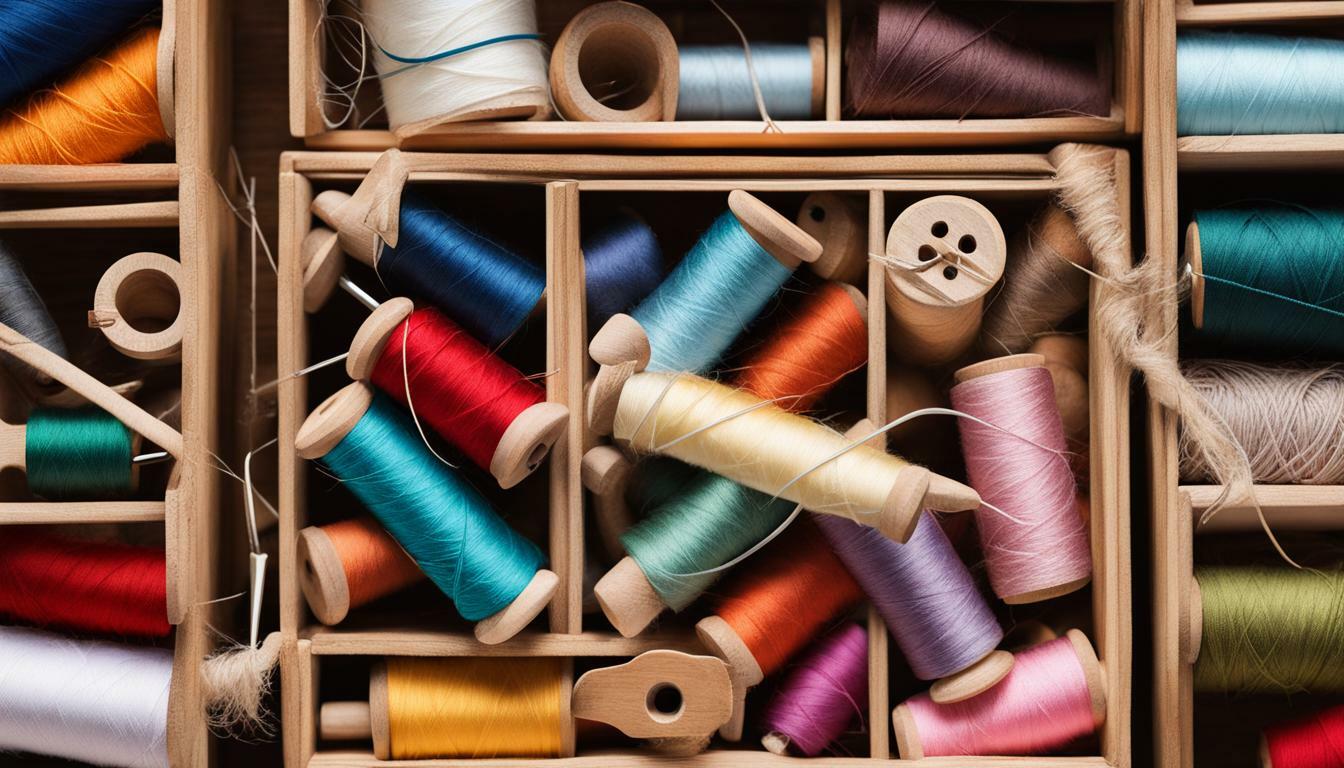As an artisanal crafter, you put your heart and soul into creating beautiful masterpieces. However, accidents can happen, and it’s important to be prepared for creative mishaps. That’s where a first aid kit specifically tailored for artisanal crafters comes in handy. With the right tools and supplies, you can handle cuts, burns, and eye injuries that can occur during your artistic endeavors.
Whether you’re a seasoned crafter or just starting out, having a crafters emergency kit is essential. In this article, we’ll explore why artisanal crafters need first aid kits, the essential items to include in your DIY crafters first aid kit, how to choose the right first aid kit, and first aid training for crafters. We’ll also provide tips on preventing accidents in your workspace and first aid tips for managing cuts and scrapes, burns and heat-related injuries, eye injuries, and allergic reactions. Finally, we’ll offer advice on maintaining and replenishing your first aid kit so that you’re always prepared for any creative mishaps that may arise.
Why Artisanal Crafters Need First Aid Kits
Artisanal crafting is a popular and fulfilling hobby, but it also comes with unique risks and hazards. A crafter’s workspace can be filled with sharp tools, hot surfaces, and dangerous chemicals, making it essential to have a first aid kit for any unexpected injuries or accidents.
First aid for crafters is crucial because unlike other activities, art and craft injury management requires specific skills, supplies, and techniques. Having a crafters safety kit on hand can make all the difference in preventing minor injuries from turning into major issues.
Crafters are particularly prone to cuts, burns, and eye injuries from handling sharp objects, hot glue guns and chemicals. A first aid kit tailored to their needs will contain the necessary supplies to deal with these mishaps.
Overall, having a first aid kit for crafters ensures that artisanal crafting can be done safely, allowing for greater creativity and enjoyment of the hobby without worrying about the potential risks.
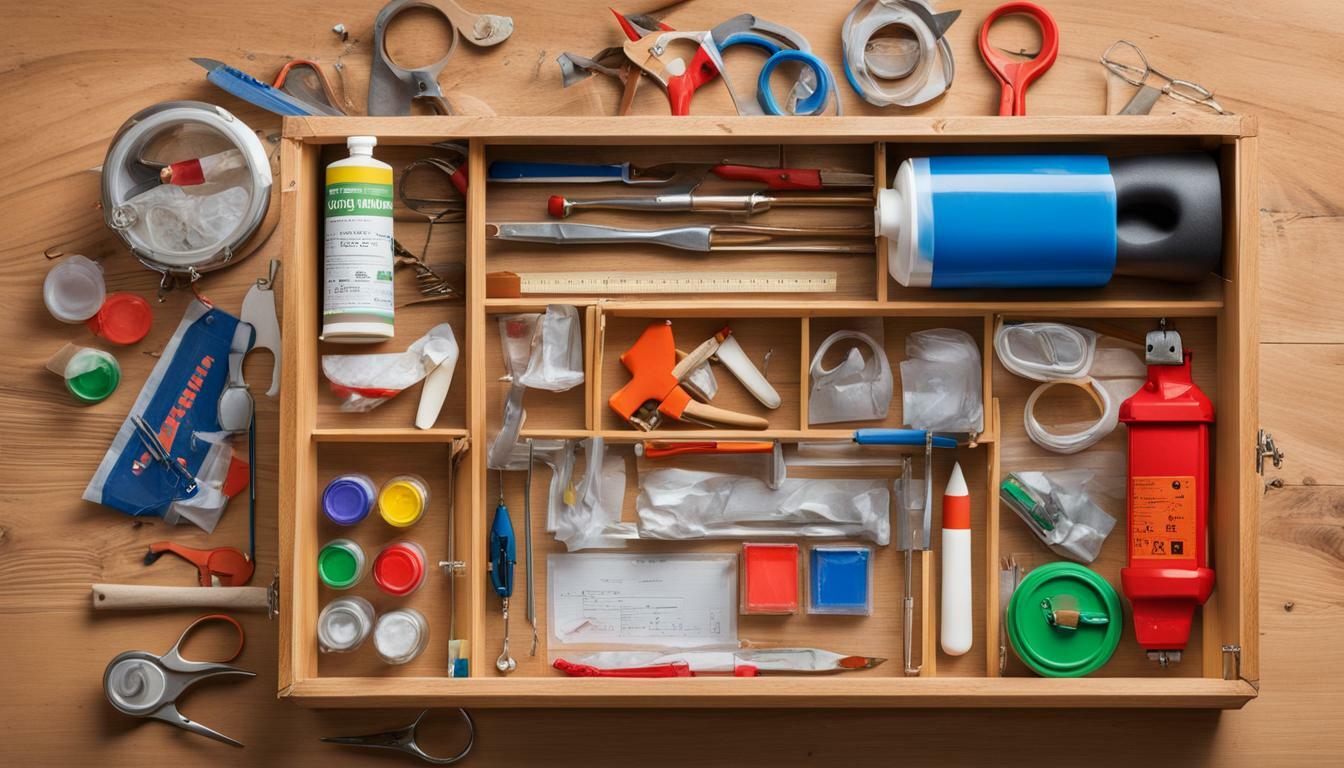
First aid for crafters is a necessary but often overlooked aspect of this hobby. It’s important to have the right supplies and knowledge to handle any potential accidents or injuries.
Essential Items in a Crafter’s First Aid Kit
Being prepared with a well-stocked first aid kit can make all the difference when dealing with creative mishaps. As a crafter, it’s important to have the right supplies on hand to deal with injuries such as cuts, burns, and eye injuries. Here are some essential items to include in your crafter’s emergency kit:
| Item | Purpose |
|---|---|
| Adhesive bandages (various sizes) | To cover and protect small cuts and scrapes. |
| Gauze pads (various sizes) | To cover larger wounds or to use as a makeshift bandage for a cut that won’t stop bleeding. |
| Antiseptic wipes | To clean wounds and prevent infection. |
| Tweezers | To remove splinters or other foreign objects from skin. |
| Cold pack | To reduce swelling and ease pain from burns or other injuries. |
| Scissors | To cut gauze or other materials as needed. |
| Gloves | To protect yourself from bodily fluids or other hazards when administering first aid. |
| Cotton swabs | To apply ointments or other treatments to wounds. |
Of course, every crafter’s first aid kit will be unique to them and their specific needs. Tailor your kit to your individual creative pursuits and any medical conditions or allergies you may have.
Creating your own DIY crafter’s first aid kit can also be a cost-effective and customizable solution. Just be sure to research and purchase high-quality medical supplies to ensure you have everything you need in case of an emergency.
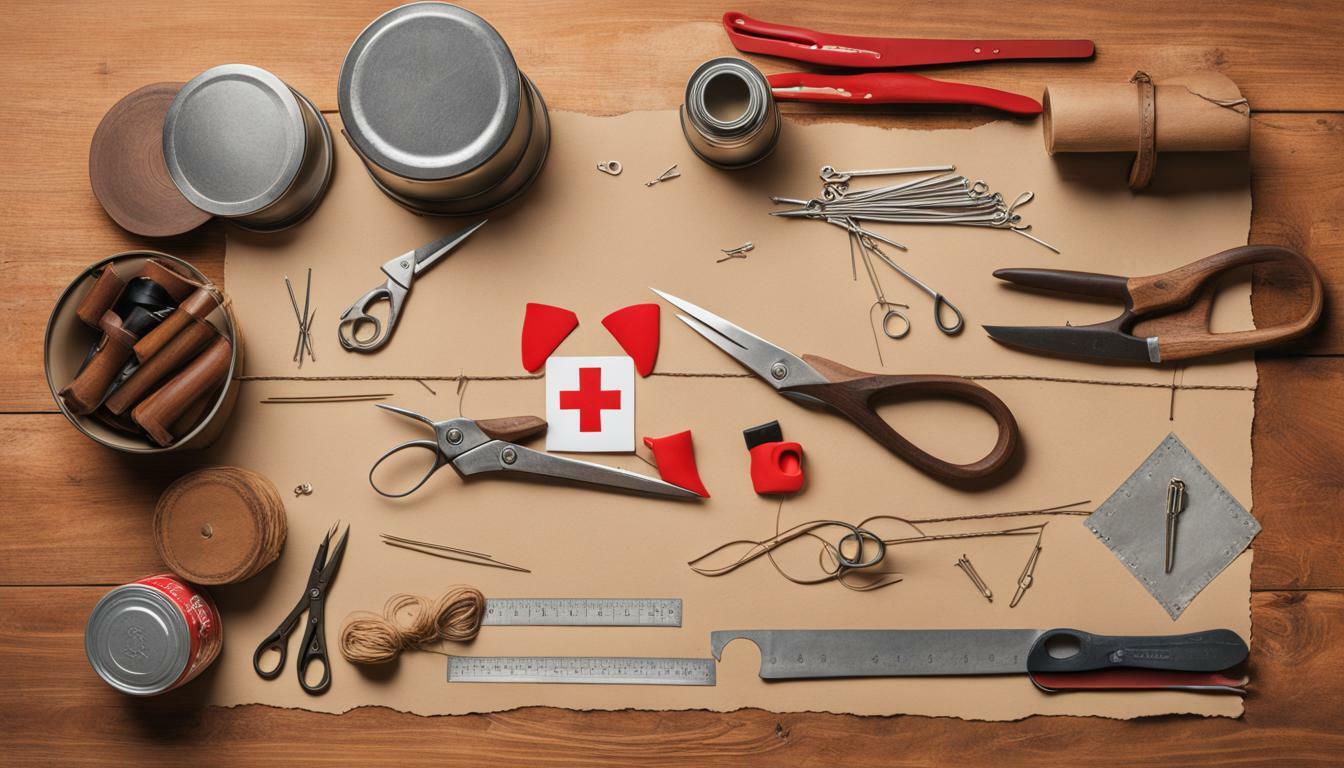
Remember, accidents can happen to anyone – even the most experienced artisanal crafter. By having a well-stocked first aid kit and the knowledge of how to use it, you can feel confident in your ability to deal with any creative mishap that may come your way.
Choosing the Right First Aid Kit for Artisanal Crafters
When it comes to choosing a first aid kit, it’s important for artisanal crafters to consider their specific needs. A standard first aid kit may not have all the necessary supplies and tools to deal with creative mishaps. Here are some factors to consider when choosing the right first aid kit:
| Factor to Consider | Explanation |
|---|---|
| The size of the kit | A smaller kit may be more convenient for portable craft projects, while a larger kit may be necessary for a stationary workspace. |
| The type of craft being pursued | Certain crafts may require specific supplies, such as a heat-resistant dressing for glassblowing or a splint for woodworking. |
| Specific medical conditions or allergies | If an artisanal crafter has a medical condition or allergy, it’s important to choose a first aid kit that can accommodate their needs. For example, an epinephrine auto-injector may be necessary for those with severe allergies. |
When it comes to the contents of the first aid kit, artisanal crafters should ensure that they have the necessary supplies to treat common creative mishaps. This may include:
- Various sizes of band-aids
- Antiseptic wipes or spray
- Tweezers for removing splinters or small foreign objects
- Cold packs to reduce swelling and pain
- Gauze and tape for larger wounds
- A small pair of scissors
Additionally, artisanal crafters may want to consider including any unique supplies or tools specific to their craft. For example, a jeweler may include a magnifying glass for precise work or a potter may include burn cream for accidental contact with hot kiln surfaces.
Ultimately, the right first aid kit for artisanal crafters will depend on their individual needs and the risks associated with their craft. By being prepared with the proper supplies and tools, artisanal crafters can confidently pursue their creative projects knowing they can effectively manage any mishaps that may occur.

First Aid Training for Artisanal Crafters
As an artisanal crafter, having a well-stocked first aid kit is essential for dealing with creative mishaps. However, it’s equally important to have the knowledge and skills to use the supplies effectively. That’s where first aid training comes in.
By taking a first aid course, you’ll learn how to handle common injuries and emergencies that can occur during your crafting pursuits. You’ll also gain the confidence to act quickly and effectively, potentially preventing more serious problems.
First aid training courses are widely available, both in-person and online. Local community centres, universities, and hospitals may offer courses, or you can search for reputable online options.
As a crafter, you may be particularly interested in courses that cover topics such as managing cuts and scrapes, handling burns, and dealing with eye injuries. Some courses may even offer specialized training for specific crafts, such as woodworking or jewelry making.
Investing in first aid training is an important step in staying safe and prepared as an artisanal crafter. Keep your safety kit well-stocked and your skills sharp, and you’ll be ready to tackle any creative mishap that comes your way.
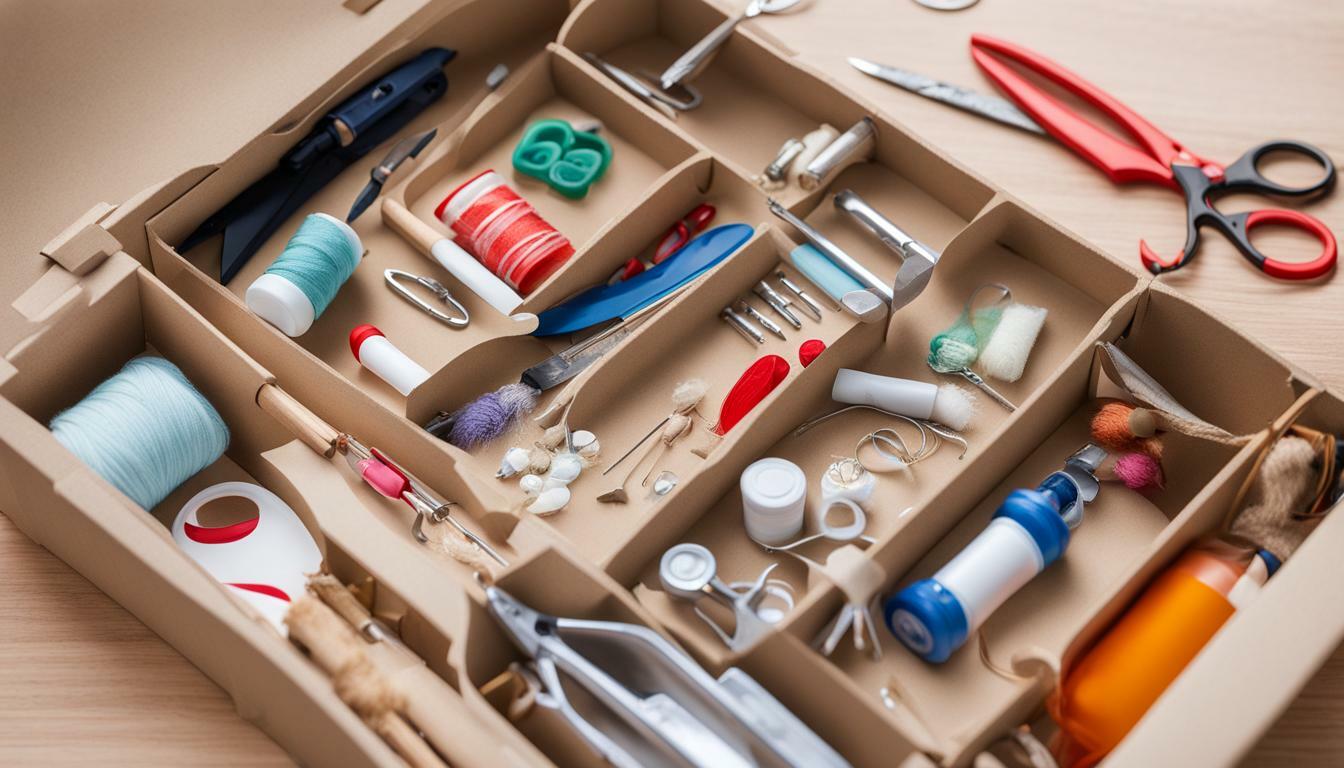
Preventing Creative Mishaps in the Artisanal Crafters’ Workspace
Artisanal crafting is a beloved hobby, but it can also be hazardous if you’re not careful. From sharp tools to hot glue guns, crafters face a variety of risks when working on their creations. It’s important to take steps to prevent accidents and injuries in the workspace to ensure safe and enjoyable crafting experiences. Here are some tips to help you stay safe:
| Tip | Description |
|---|---|
| Invest in proper tools and equipment | Using the right tools can prevent accidents. Make sure you have the appropriate tools for the craft you’re working on, and keep them in good condition. Replace broken or dull tools immediately. Consider investing in ergonomic tools to reduce strain on your hands and wrists. |
| Organize your workspace | A cluttered workspace can be dangerous. Keep your supplies and tools organized and put away when not in use. This will reduce the risk of tripping, falling, or accidentally knocking over a sharp tool or hot glue gun. |
| Practice good posture | Sitting or standing in the same position for extended periods can lead to muscle strain and injuries. Take regular breaks and stretch your muscles. Use a comfortable chair if you’re sitting for long periods and adjust the height of your work surface to ensure proper posture. |
| Use protective gear | Wear protective gear such as gloves, goggles, and aprons when working with hazardous materials or tools. For example, wear goggles when working with power tools to protect your eyes from flying debris. |
By following these tips, you can create a safer and more enjoyable crafting experience. However, accidents can still happen. In the next section, we’ll discuss first aid tips specifically for managing cuts and scrapes, which are some of the most common creative mishaps.
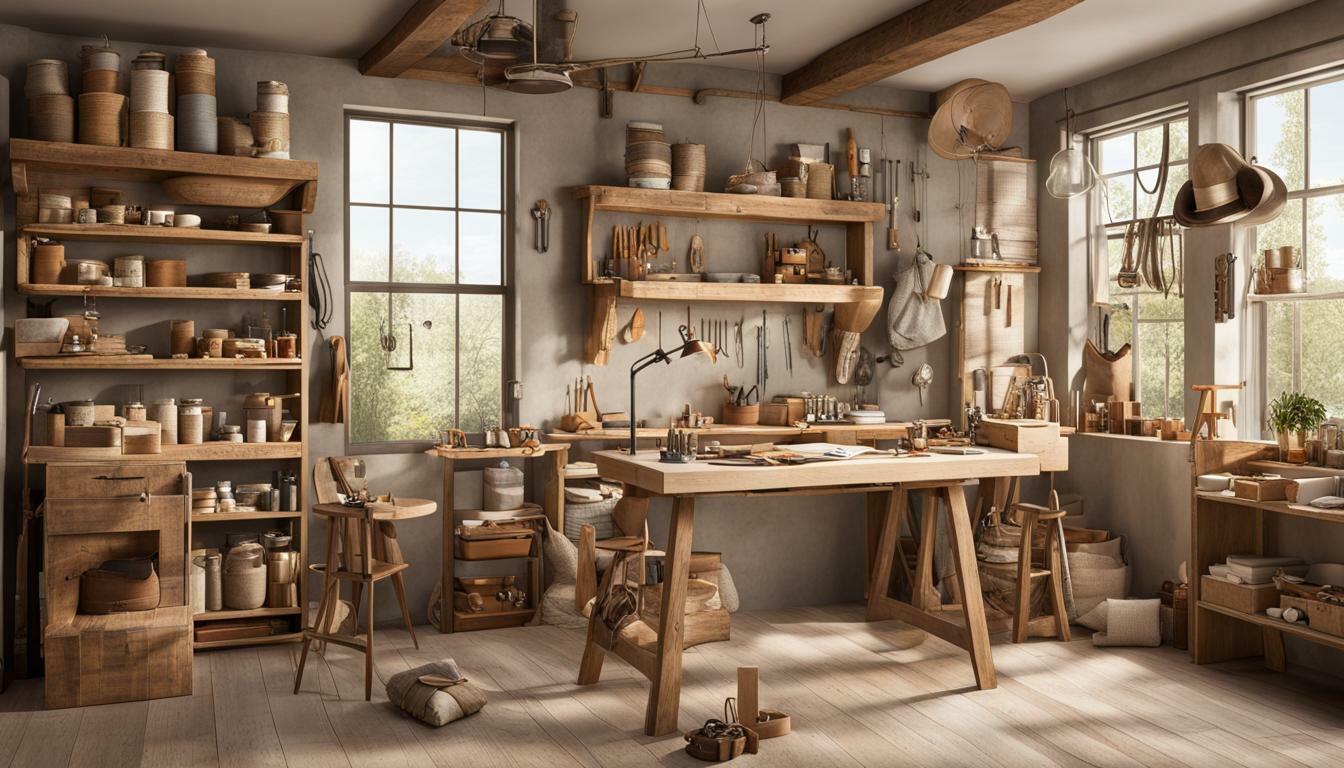
Managing Cuts and Scrapes: First Aid Tips for Artisanal Crafters
As any artisanal crafter knows, cuts and scrapes are an all too common occurrence in the creative workspace. It’s important to be prepared with the right first aid supplies and knowledge to properly manage these mishaps and prevent infection.
Here are some first aid tips for managing cuts and scrapes:
| Step | Action |
|---|---|
| 1 | Stop the bleeding by applying gentle pressure with a clean cloth or bandage. |
| 2 | Clean the wound with soap and water or an antiseptic wipe. Do not use hydrogen peroxide or alcohol, as these can damage the tissues. |
| 3 | Apply an antibiotic ointment or cream to prevent infection. |
| 4 | Cover the wound with a sterile bandage or gauze to keep it clean and protected. |
| 5 | Change the bandage daily or as needed, and watch for signs of infection such as redness, swelling, or pus. |
If the wound is deep, gaping, or bleeding heavily, seek medical attention immediately. And always make sure your first aid kit is stocked with an ample supply of band-aids, gauze, antiseptic wipes, and other essentials for DIY crafters first aid.

“As a crafter, you never know when you might accidentally slip with a sharp tool or burn yourself with hot glue. That’s why having a well-stocked first aid kit and knowing how to properly handle cuts and scrapes is crucial. Safety first, creativity second!”
Dealing with Burns and Heat-Related Injuries in Artisanal Crafting
Artisanal crafting often involves the use of hot tools and materials, such as soldering irons and hot glue guns. This increases the risk of burns and heat-related injuries, which can range from minor to severe.
For minor burns, it’s important to immediately cool the affected area with cold water or a cold compress. Avoid using ice, as it can damage the skin. Apply a sterile bandage or a burn ointment to prevent infection and promote healing.
However, if a burn is severe or covers a large area, seek immediate medical attention. In the meantime, remove any clothing or jewelry around the affected area, and do not try to break any blisters that may have formed.
Heat-related injuries such as heat exhaustion or heatstroke can also be a concern, especially when working in a hot environment. Symptoms include dizziness, nausea, and a rapid heartbeat. To prevent these injuries, stay hydrated and take frequent breaks in a cooler area.
If you suspect that someone is experiencing heat exhaustion or heatstroke, move them to a cooler area, and have them lie down. Apply cool compresses to their forehead, neck, and armpits. If they are conscious, have them sip water slowly. If their symptoms do not improve within 30 minutes, seek medical attention immediately.
It’s important to have the right tools and supplies in your crafter’s emergency kit to deal with burns and heat-related injuries. This can include burn ointments, sterile bandages, and instant cold packs. Remember to regularly check your kit for the expiration date of its contents and restock any used items to ensure you’re well-prepared for any creative mishaps.

Dealing with Burns and Heat-Related Injuries in Artisanal Crafting: Key Points
- Minor burns should immediately be cooled with cold water or a cold compress
- Avoid using ice on burns, apply sterile bandage or burn ointment
- Severely burned areas need immediate medical attention
- Heat-related injuries can be prevented by staying hydrated and taking breaks in a cooler area
- Symptoms of heat exhaustion or heatstroke include dizziness, nausea, and a rapid heartbeat
- Move the person experiencing these symptoms to a cooler area and seek medical attention if necessary
- Include burn ointments, sterile bandages, and instant cold packs in your crafter’s emergency kit
- Check your emergency kit regularly and restock used items
Eye Safety and First Aid for Artisanal Crafters
Eye safety is crucial for artisanal crafters when working with sharp tools, heavy machinery and chemicals. Serious eye injuries can occur when proper precautions are not taken. This section will provide tips on how to prevent eye injuries and what to do in case of an eye injury.
It is important to wear appropriate eye protection such as goggles or safety glasses to prevent debris and chemicals from entering the eye. Regular glasses or sunglasses are not sufficient protection against injury.
If an injury does occur, it is important to act quickly. Do not rub the eye or try to remove any object that may be lodged in it. Wash your hands thoroughly, then hold the unaffected eye closed and seek medical attention immediately.
If chemicals splash into the eye, flush the affected eye with water continuously for at least 15 minutes. Do not use any eyewash solutions without consulting a doctor or medical professional.
If a foreign object is in the eye, do not attempt to remove it yourself. Seek medical attention immediately. Cover the affected eye with a sterile dressing or clean cloth until you can get medical treatment.
By following these safety tips and being prepared, you can avoid serious eye injuries while practicing your craft. Make sure to include eye protection and first aid supplies in your craft emergency kit and always seek medical attention if necessary.
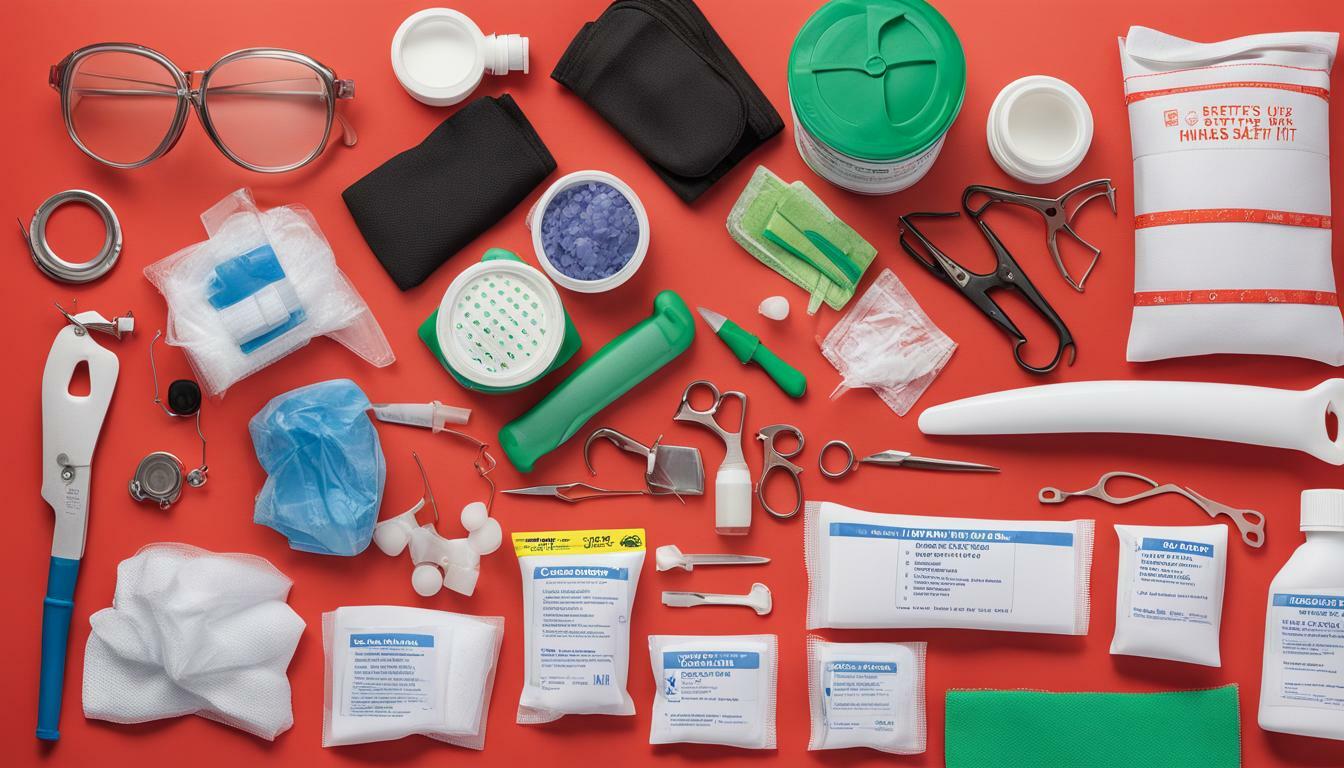
First Aid for Allergic Reactions in Artisanal Crafting
As an artisanal crafter, you may be exposed to various allergens that can cause discomfort or even danger. Allergic reactions can be triggered by dust, mold, pollen, or chemicals commonly used in crafting. It’s important to be prepared for these scenarios and have a first aid kit that includes items to manage allergic reactions.
The first step in providing first aid for an allergic reaction is to recognize the symptoms. These can include skin rash, swelling of the face or throat, difficulty breathing, or a sudden drop in blood pressure. If you or someone around you experiences any of these symptoms, it’s crucial to act quickly to avoid a severe reaction.
If you’re experiencing a mild allergic reaction, the first thing to do is to remove yourself from the source of the allergen and take an antihistamine, such as loratadine or cetirizine. These over-the-counter medications can help to relieve itching, sneezing, and runny nose.
If you have a more severe allergic reaction, such as anaphylaxis, it’s important to seek medical attention immediately. Anaphylaxis is a severe allergic reaction that can cause the body to go into shock. Symptoms include difficulty breathing, swelling of the face and throat, and a rapid heartbeat. If left untreated, anaphylaxis can be life-threatening.
Your crafters emergency kit should contain antihistamines, disposable gloves, and ice packs, as well as an auto-injector of adrenaline, such as an EpiPen, if you are at high risk of anaphylaxis. Make sure your kit is always up-to-date and that all supplies are within their expiration dates.
Managing allergic reactions may seem overwhelming, but with the right preparation and knowledge, you can ensure your safety and continue to enjoy your artistic pursuits.
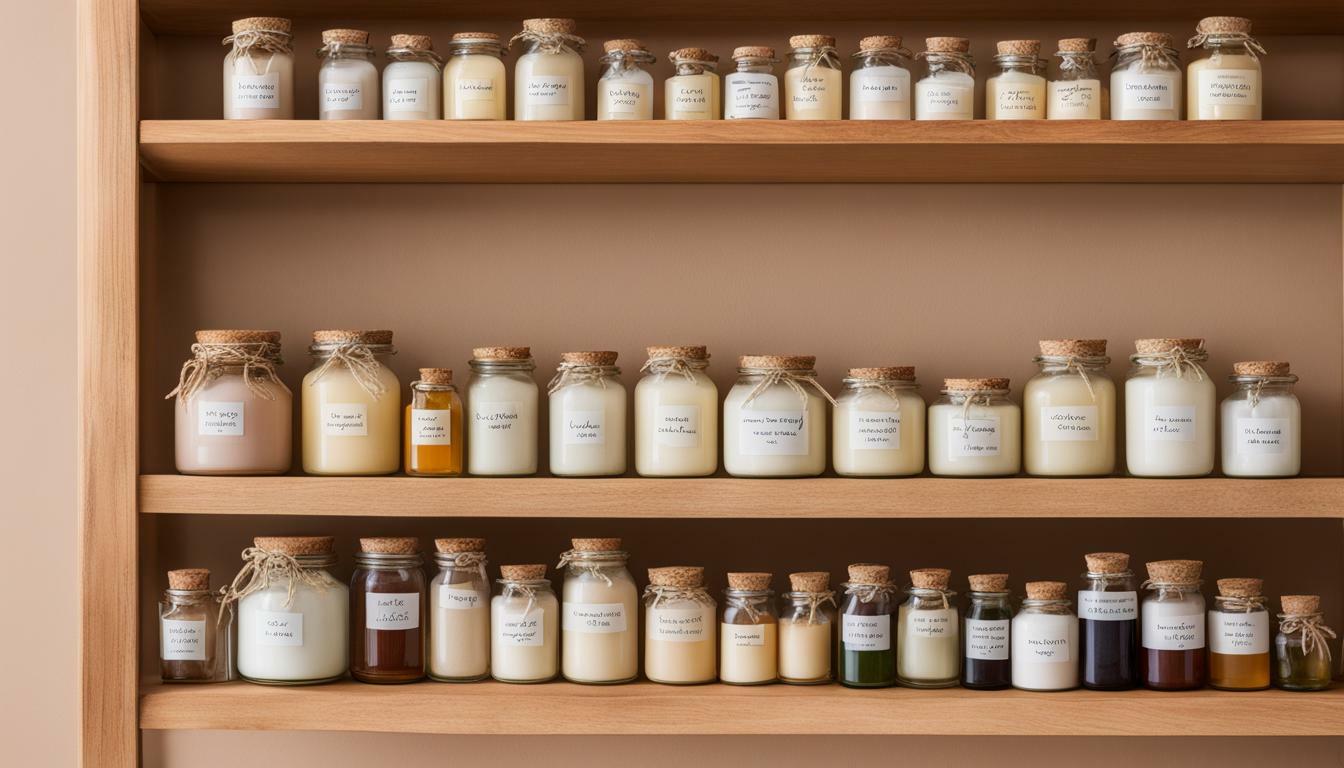
Staying Safe and Creative: First Aid Kit Maintenance Tips
As an artisanal crafter, it is important to have a well-stocked and regularly maintained first aid kit to deal with any creative mishaps or injuries that may occur. Here are some essential tips for maintaining your first aid kit:
| Tip | Description |
|---|---|
| Check for expiration dates | Regularly check the expiration dates of all items in your first aid kit, such as band-aids, antiseptic wipes, and medications. Remove and replace any items that are expired. |
| Restock used items | After using any items from your first aid kit, make sure to restock them as soon as possible so that your kit is always complete and ready for use. |
| Keep it clean | Store your first aid kit in a clean and dry place to prevent contamination of supplies. Wipe down the case or container regularly to keep it free of dirt and dust. |
| Make it accessible | Keep your first aid kit easily accessible in your workspace. Make sure that it is visible and within reach so that you can quickly access it in case of an emergency. |
| Create a checklist | Create a checklist of all items in your first aid kit, so you can easily track which items need to be replenished. This will help you make sure that you always have all the necessary supplies on hand. |
By following these simple tips, you can ensure that your first aid kit is always in good condition and ready to use. Remember, a well-prepared first aid kit is an essential item for any artisanal crafter, and can help you stay safe and creative in your workspace.
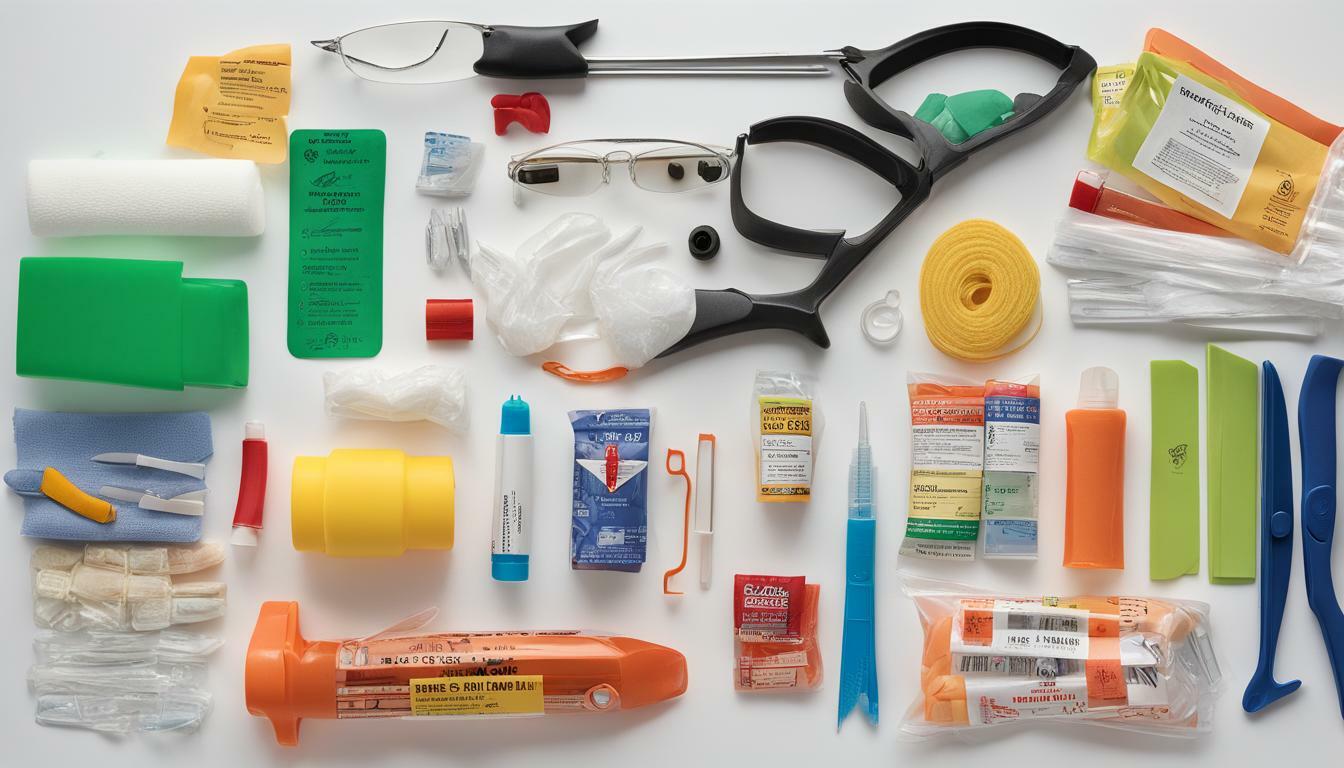
Conclusion
Artisanal crafting can be a fulfilling and rewarding hobby, but it’s important to be prepared for accidents and injuries that can happen in the creative process. A well-stocked and maintained first aid kit can provide peace of mind and the tools necessary to address common mishaps such as cuts, burns, and eye injuries.
Choosing the right first aid kit for your needs is crucial, as is investing in first aid training to know how to properly handle emergency situations. By creating a safe and ergonomic workspace, taking precautions such as wearing protective goggles or glasses, and regularly checking and replenishing your first aid kit, you can stay safe and creative in your artisanal crafting pursuits.
